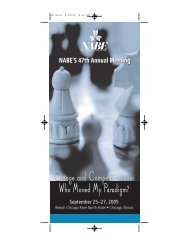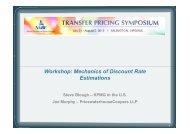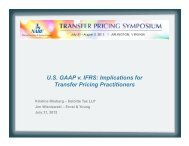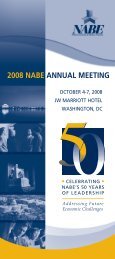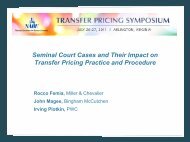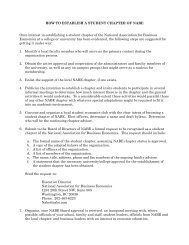An Econometric Analysis of Consumer Sentiment and ... - NABE
An Econometric Analysis of Consumer Sentiment and ... - NABE
An Econometric Analysis of Consumer Sentiment and ... - NABE
- No tags were found...
Create successful ePaper yourself
Turn your PDF publications into a flip-book with our unique Google optimized e-Paper software.
ate adds 3.19% to consumer sentiment <strong>and</strong> 6.99% to consumer confidence. The "Stock Market Effect" is symmetric<strong>and</strong> continuous.DJIA Trigger Effect: There is another impact that the stock market can have on consumer attitudes that isindependent <strong>of</strong> the so-called Stock Market Effect <strong>and</strong> is similar to the Gasoline Price Trigger Effect. When the DowJones Industrial Average (DJIA) increases <strong>and</strong> surpasses a round 1,000-point level—for example, from 11,950 to12,150—there is an extra upward spike <strong>of</strong> 0.78% to consumer sentiment <strong>and</strong> 2.48% to consumer confidence. TheDJIA is widely followed <strong>and</strong> seems to enter consumers' psyche more readily in terms <strong>of</strong> personal milestones thanother stock market indicators.Labor Market Conditions (Initial Claims <strong>and</strong> the Unemployment Effect): Labor market conditions are a criticalcomponent to overall consumer conditions. Initial claims for unemployment insurance benefits <strong>and</strong> the unemploymentrate have a different dynamic <strong>and</strong> each impacts consumer attitudes in a negative, yet different way. A 10% increasein monthly average initial claims for unemployment benefits (per civilian population 16 years <strong>of</strong> age <strong>and</strong> older)subtracts 2.05% from consumer sentiment <strong>and</strong> 2.93% from consumer confidence. The unemployment rate does nothave a statistically significant impact on consumer sentiment; however it does on consumer confidence. A 10%increase in the unemployment rate places downward pressure <strong>of</strong> 1.18% on consumer confidence. This is easilyexplained by the prominence <strong>and</strong> importance the media places on the unemployment rate <strong>and</strong> its monthly updates.Since the unemployment rate <strong>and</strong> initial claims are lagging indicators <strong>of</strong> the economy, it is easily understood thatconsumer sentiment <strong>and</strong> confidence lag behind the Institute <strong>of</strong> Supply Management indicators <strong>and</strong> the stock marketindexes.Recessions <strong>of</strong> 2001 <strong>and</strong> 2007: The 2001 recession lasted from March 2001 to November 2001. There is nostatistical evidence that it contributed to the decline in consumer sentiment or consumer confidence when all theother factors were accounted for. However, when considered in the context <strong>of</strong> the consumer confidence index, itcontributed to a 3.01% increase during the recession period.On the other h<strong>and</strong>, the Great Recession (from December 2007 through June 2009) had a clear <strong>and</strong> statisticallysignificant effect on both consumer indexes, with reductions <strong>of</strong> 3.16% on consumer sentiment <strong>and</strong> 6.20% onconsumer confidence during the recession months. This result is consistent with previous IHS Global Insight researchinto the causes <strong>of</strong> the recessions. The 2001 recession was milder (in GDP terms) <strong>and</strong> qualitatively different from the11 IHS Global Insight Published 7/1/11




